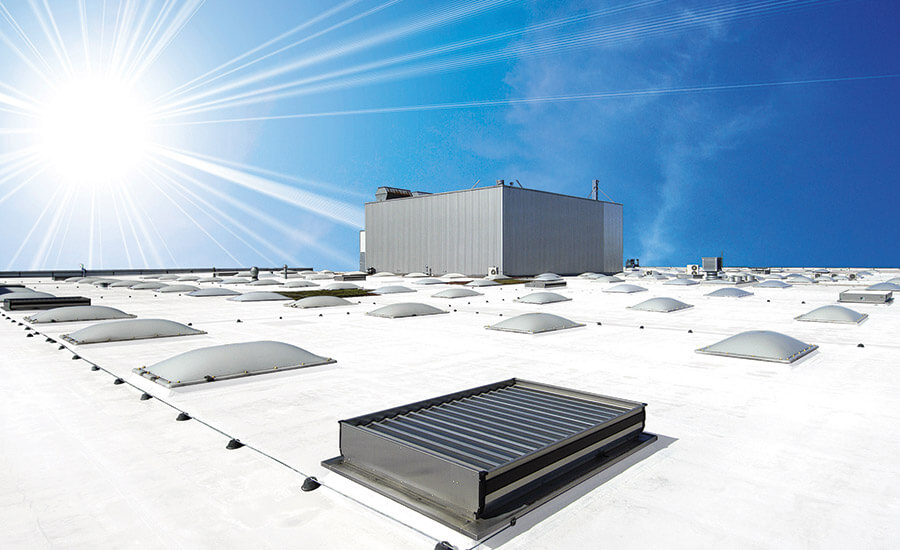Environmental Impact of roof coatings vs traditional

In recent years, the focus on sustainable and environmentally friendly practices has extended to various industries, including commercial roofing. As businesses strive to reduce their carbon footprint and lower energy costs, the choice between roof coatings and traditional roofing materials has become a topic of interest. This blog aims to explore the environmental impact of roof coatings compared to traditional commercial roofing, highlighting the benefits of embracing eco-friendly alternatives.
Energy Efficiency
One of the significant environmental benefits of roof coatings is their ability to enhance energy efficiency. Traditional commercial roofing materials, such as asphalt or metal, absorb a significant amount of solar heat, leading to increased cooling demands within the building. In contrast, roof coatings are designed to reflect sunlight, reducing the amount of heat absorbed by the roof surface. This reflective property, known as solar reflectance, helps mitigate the urban heat island effect and lowers the building’s energy consumption by reducing the need for excessive air conditioning.
Reduced Heat Island Effect
The urban heat island effect occurs when urban areas experience higher temperatures due to the concentration of heat-absorbing materials like concrete and asphalt. Traditional commercial roofing materials contribute to this effect by absorbing and radiating heat, thereby increasing ambient temperatures. Roof coatings with high solar reflectance properties help combat the heat island effect by reflecting sunlight and reducing the amount of heat absorbed by the roof. By adopting roof coatings, businesses can contribute to a more comfortable and sustainable urban environment.
Extended Roof Lifespan
Roof coatings can extend the lifespan of commercial roofs, reducing the environmental impact associated with frequent roof replacements. Traditional roofing materials are subject to weathering, UV exposure, and thermal expansion, leading to deterioration over time. Roof coatings act as a protective layer, shielding the underlying roofing material from the elements and reducing wear and tear. By increasing the longevity of the roof, coatings minimize the need for resource-intensive roof replacements, ultimately reducing waste and conserving materials.
Waste Reduction
When traditional commercial roofs reach the end of their lifespan, they often require complete replacement. This process generates a significant amount of waste, as the old roofing materials must be removed and disposed of. In contrast, roof coatings can be applied directly over existing roofs in many cases, reducing the amount of waste generated during installation. By eliminating the need for tear-offs and reducing landfill waste, roof coatings contribute to a more sustainable approach to commercial roofing.
Volatile Organic Compounds (VOCs) Emissions
Volatile Organic Compounds (VOCs) are harmful chemicals that can be released into the atmosphere from various sources, including traditional roofing materials. These VOC emissions contribute to air pollution and can have detrimental effects on human health and the environment. Roof coatings, particularly those with low VOC content, provide a more environmentally friendly alternative. They minimize the release of harmful chemicals during application and contribute to healthier indoor and outdoor air quality.
Reduced Energy Consumption
As roof coatings enhance energy efficiency by reducing heat absorption, they contribute to lower energy consumption and associated greenhouse gas emissions. By reducing the need for excessive air conditioning, businesses can reduce their reliance on fossil fuel-powered energy sources. This, in turn, helps mitigate climate change and supports global efforts to transition to renewable energy.
Water Runoff and Stormwater Management
Roof coatings can also play a role in managing stormwater runoff, an important aspect of sustainable urban design. Traditional commercial roofs, especially those with impervious surfaces, can contribute to increased stormwater runoff, leading to issues such as erosion and pollution of water bodies. Roof coatings, particularly those with reflective and permeable properties, can help minimize stormwater runoff by promoting water absorption and reducing the volume of water reaching the ground. This supports overall water management efforts and helps alleviate strain on local drainage systems.
Maintenance and Durability
Roof coatings offer added durability and ease of maintenance compared to traditional roofing materials. Coatings provide an extra layer of protection against weathering, UV rays, and physical damage. Their reduced need for maintenance and repairs translates to fewer resources consumed and less waste generated over the roof’s lifespan.
The environmental impact of roof coatings compared to traditional commercial roofing materials is significant. From energy efficiency and reduced heat island effect to extended roof lifespan and waste reduction, roof coatings offer a sustainable alternative for businesses seeking to reduce their environmental footprint. By embracing eco-friendly roofing practices, businesses can contribute to a greener future while enjoying numerous benefits, including cost savings, improved energy efficiency, and enhanced building performance.

